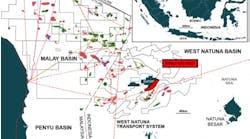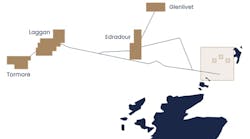The offshore oil and gas industry has embraced the world of artificial intelligence, driven by the ever-growing need to make operations safer and more efficient. In every segment of the offshore E&P industry, operators, contractors, and service companies are incorporating AI technology into their systems and processes. The potential benefits of AI are particularly compelling for the industry as a means of mitigating the challenges of continued price volatility, cost pressure, and staffing requirements.
Over the past year, AI technologies have been incorporated and deployed by companies spanning the exploration, production and field development segments of the offshore oil and gas industry. Some of the more notable developments are described below.
Geosciences and exploration
TGS has formed a collaboration agreement with analysis and machine learning specialist Earth Science Analytics concerning data-driven geoscience. The companies have already worked together to develop derivative datasets for TGS’ Utsira ocean bottom node (OBN) survey, created through artificial intelligence analysis. This project – the first example involving AI geological interpretation on a large-scale, densely sampled OBN exploration dataset – covered more than 1,500 sq km (579 sq mi). The main aim was to develop new derivative seismic products to provide enhanced exploration insights through AI, especially in areas of infrastructure-led exploration. Combining training, ‘ground truth’ well data anchoring, blind testing, high fidelity seismic, and AI technology results in accurate predictions, TGS says.
Elsewhere, Wintershall Dea is applying an artificial intelligence search engine to support its exploration processes. The Exploration Advisory Tool, developed with IBM and successfully piloted last year, uses cognitive search technology that provides fast access to Wintershall Dea’s exploration teams. The AI-powered tool takes information from ‘unstructured’ data such as reports or presentations, and unlike a keyword search, is designed to ‘think’ like a geologist, understanding and extracting data related to a ‘formation’, ‘reservoir,’ or other concepts.
This saves the teams time spent manually searching for the same data. “Artificial intelligence can help us make better decisions about expected gas and oil volumes in the early stages of the value chain,” said Hugo Dijkgraaf, the company’s chief technology officer. “Digital transformation at Wintershall Dea is about enhancing competitiveness and reducing risk. The roll-out of the Exploration Advisory Tool does exactly that, by enabling better and faster decision making.”
Drilling operations
Halliburton Co. has introduced the iStar intelligent drilling and logging platform. This is a comprehensive measurement platform comprising multiple services for greater control of drilling and logging operations. The platform’s digital architecture supports automation, machine learning, and artificial intelligence for reservoir evaluation, faster drilling, and consistent well delivery.
The company said the new platform acquires high-definition measurements closer to the bit and deeper into the formation for enhanced subsurface insight. It provides real-time visibility of the type and quantity of reservoir fluids and uses data science techniques to optimize reserves calculations and improve well placement.
The technology is said to help maximize the rate of penetration through integrated drilling dynamics and continuous well positioning measurements. The company said it designed the platform with more sensors and fewer collars, significantly reducing the bottomhole assembly length and decreasing the number of connections to improve reliability.
Meanwhile, Asystom and Archer have formed a technology co-operation covering use of Asystom’s predictive maintenance technology for oil and gas drilling facilities.
The company’s predictive maintenance solution combines machine learning with multi-sensors for prediction. The partners plan further development for drilling facilities worldwide to improve asset management.
Peter Nygaard Andersen, vice president Engineering at Archer, said: “Asystom’s technology is easily adaptable to our industry and meets the market demands for improved asset management by use of artificial intelligence.”
He added: “Machinery learning will enable us to predict and avoid shutdowns, thus reducing non-productive time significantly. The system will aid the asset owner to further reduce cost by enhanced condition control and optimizing maintenance planning. Consequently, the system will respond to our goals to reduce our industry’s carbon footprint.”
André Naccache, managing director of Asystom, said the IoT predictive maintenance solution would help oil and gas drilling contractors “future-proof” their operations. “The solution will improve the productivity and thus the profitability of the production units by avoiding unscheduled shutdowns,” Naccache said. Archer will market the technology, and also provide Asystom with competency and knowledge based on its drilling experience.
Field development
ABS has issued new technology qualification to SBM Offshore’s AI-powered Intelligent Agent Mooring Line Integrity Tool. This allows the technology to be integrated into offshore systems for the first time. The tool is designed to collect data such as wind speed, FPSO heading, and GPS information, and couple that data with machine learning approaches to provide the asset owner with continuous feedback on the integrity of its mooring system. The tool can detect potential mooring line failure and location without reliance on a traditional tension monitoring system, due to the potential for deeper insight offered by AI techniques.
Matt Tremblay, ABS senior vice president, Global Offshore, said: “This technology enables the continuous monitoring of the integrity of mooring lines and has significant potential to advance safety in the offshore industry.”
Oivind Tangen, SBM Offshore Managing Director, Operations, said: “This achievement is only one example of how SBM Offshore is using digitalization to make meaningful shifts in offshore operations, making them safer, more reliable, and more efficient. It is just the beginning of the application of machine learning in our offshore operations.”
Production operations
Artificial intelligence technology has been developed for a new real-time offshore inspection solution, capable of autonomous detection and categorization of equipment anomalies.
The Augmented Machine Vision Solution (AMVS) was co-developed over 12 months by Wood and National Energy Resources Australia (NERA) for inspection of critical industrial equipment, in particularly for subsea oil and gas infrastructure.
Azad Hessamodini, president of Growth & Development at Wood, said: “The AMVS will deliver a safer and faster inspection approach which can provide operators with more accurate and up-to-date information to help maximize the output of their assets. It’s a game-changer for inspections that we know are susceptible to human error and inconsistencies.”
Instead of sending technicians offshore to view numerous hours of footage recorded by inspection devices, the AMVS’ AI engine allows it to perform this task, searching for potential faults and flaws that may warrant further inspections or repairs undertaken.
Wood claims the solution could generate annual savings of AUD$2.8 billion ($2.03 billion) per year for the offshore energy industry.
Elsewhere, Shell has announced the launch of VitalyX, powered by Shell Remote Sense and Bently Nevada, a Baker Hughes business, as an advanced analytics-based oil condition monitoring and machine health service for the marine sector. VitalyX is said to combine Shell Remote Sense lubricant analysis expertise with Bently Nevada’s 60-year experience in condition monitoring and protection to offer an early warning system that remotely monitors oil quality to increase machine uptime.
By deploying industrial internet of things and artificial intelligence technology in innovative ways, the companies say that the service uses real-time sensor data and machine learning to provide customers with actionable insights to optimize equipment health, lower maintenance costs and increase operational efficiency of marine vessels.
Subsea operations
Saipem’s recently introduced Hydrone-R underwater intervention drone (UID) employs artificial intelligence in its subsea construction and inspection capabilities. The Hydrone-R is part of Saipem’s Subsea Robotics Innovation Program conceived to support remote, low-carbon and safe operations in the offshore energy market. Hydrone-R, developed and engineered by Sonsub, is a UID capable of performing construction works as well as advanced autonomous inspections on a wide range of subsea assets thanks to the embedded, proprietary artificial intelligence features.
The vehicle can remain underwater uninterruptedly for up to 12 months, hosted on a subsea docking station, either proprietary or provided by the customer for battery recharging and mission data uploading/downloading. This makes it the first ever resident subsea drone, the company claims.
When set in resident mode, the Hydrone-R can be remotely supervised and operated from onshore via a remote control room, leveraging on through-water communication links. As an alternative, it can work in fully autonomous mode within an intervention area of +10-km (6-mi) radius. Larger distances can be covered by introducing additional intermediate subsea docking stations, the company said.
Looking forward
Artificial intelligence has the potential to transform the offshore E&P business, analysts say. Already, the development of AI has led to the rise of applications such as precision drilling systems and automated inspection technologies. In the future, for the offshore oil and gas industry, analysts predict that AI will make its greatest gains in minimizing unplanned downtime and maximizing production; reducing production costs; improving health and safety management; and offering advanced cyber threat detection.




